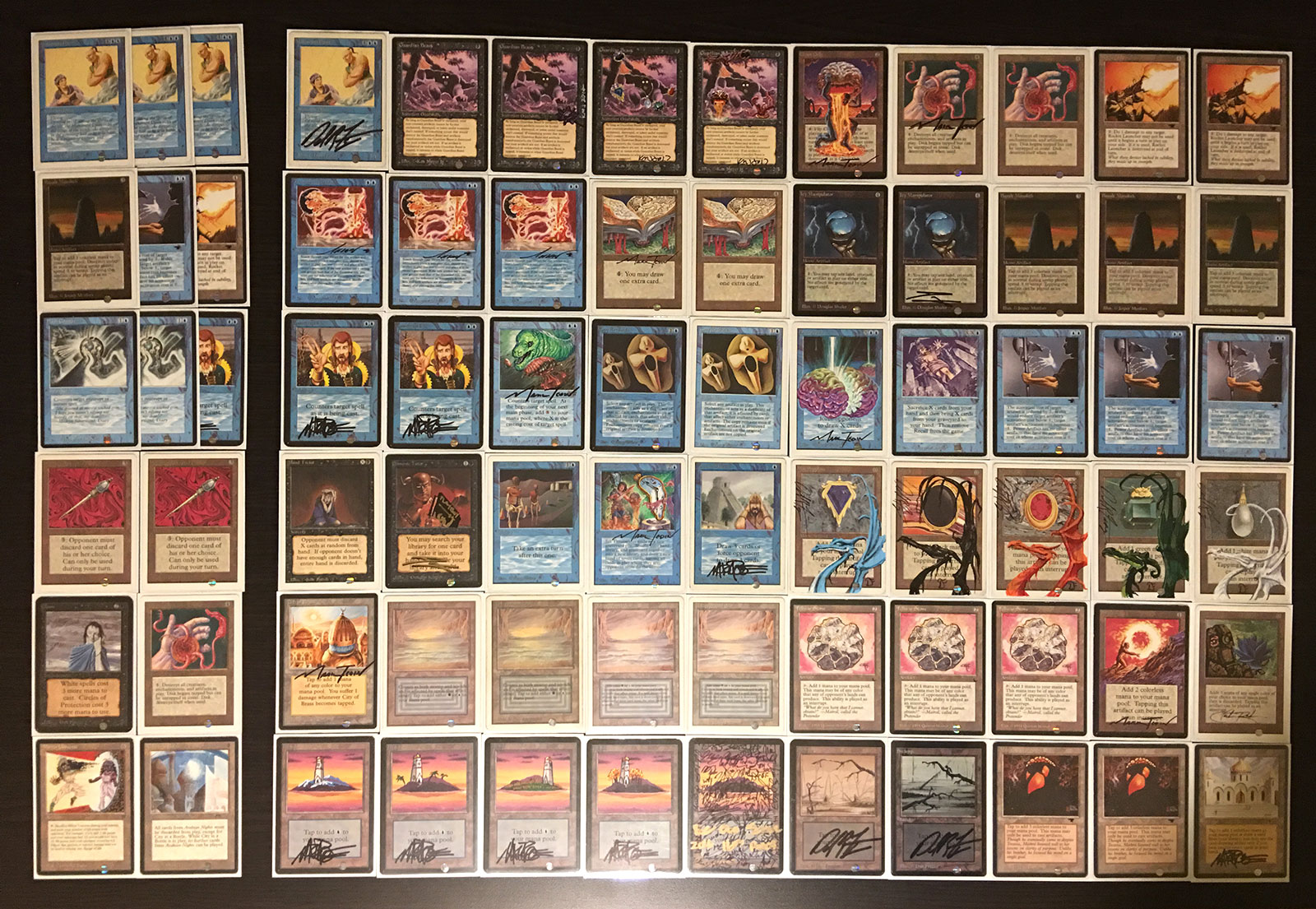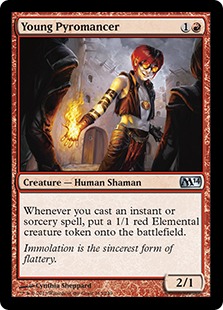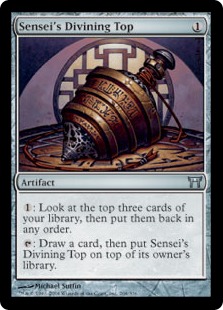When Monastery Mentor was spoiled I immediately knew it was the kind of card that could draw me away from my lord and savior, Mishra. Other creature strategies have risen to prominence over the last few years, mainly centered around Delver of Secrets, but I never felt the urge to sleeve the insect up. I’m not a fan of Delver of Secrets as a magic card or the URx shells it resides in for Vintage. My reasoning is that I get so few chances to play paper Vintage, so when I do I don’t want to play a Legacy deck. For this same reason I don’t want to play something like BUG Tempo in Vintage, or Merfolk, even though they may be viable decks. I want to do borderline broken things with my own spells, or I want to oppress others and make them wish they hadn’t gotten in the car that morning. Hence my affinity for Workshops. On the surface, Monastery Mentor seemed to be on a different level of broken than these other creature pillars, so I set out to put a deck together with it.

 The first comparison is naturally to Young Pyromancer. Young Pyromancer has seen extensive play in both aggro control decks like URx Delver, and in control or combo shells as a finisher that naturally compliments a turn full of Gushing, Digging, and Preordaining. They share many similarities, some of which are obvious.
The first comparison is naturally to Young Pyromancer. Young Pyromancer has seen extensive play in both aggro control decks like URx Delver, and in control or combo shells as a finisher that naturally compliments a turn full of Gushing, Digging, and Preordaining. They share many similarities, some of which are obvious.
1) The ability to flood the board with creatures and maintain parity. This allows for the owner of a Pyromancer to clog up the ground, making combat less profitable for the opposition. Even the threat of a mid-combat Gush or Brainstorm can create a situation where your opponent isn’t willing to risk an attack with and X/1 or X/2. The added permanents can also help neuter the effects of Tangle Wire and/or Smokestack.
2) It can end the game quickly if unchecked. Unlike something like Dark Confidant, which may win the game in a more subtle way by providing card advantage, Pyromancer and Mentor can easily create lethal damage with the investment of just one creature spell. This is often achieved by chaining cheap, efficient spells. In most Pyromancer builds this involves the format’s most degenerate draw spells and cantrips like Gush, Ancestral Recall, Gitaxian Probe, Preordain, and formerly a full set of Treasure Cruises.
Now, the differences.
 1) 2 != 3. This is a big gap in Vintage. For the uninitiated, any spell of 1X (X being a color) can reliably be cast with a land and any Mox, often on the first turn, before much opposing countermagic is online. Mentor’s gaping 2 hole in his casting cast incentivizes us to play more off-color Moxen to facilitate his casting. The Moxen in question leads to the next difference, which is huge.
1) 2 != 3. This is a big gap in Vintage. For the uninitiated, any spell of 1X (X being a color) can reliably be cast with a land and any Mox, often on the first turn, before much opposing countermagic is online. Mentor’s gaping 2 hole in his casting cast incentivizes us to play more off-color Moxen to facilitate his casting. The Moxen in question leads to the next difference, which is huge.
2) Mentor triggers on all non-creature spells, period. Young Pyromancer, while a fine card, only triggers when instants or sorceries are cast. This means Pyromancer builds chose to eschew off-color Moxen and other artifact accelerants in order to run a higher density of cantrips, cantripping into land where needed, but in the mid to late game having a higher density of business left in their library. Mentor wants Moxes. Lots of them. Off-color Moxen not only help cast the more expensive monk but can also be sandbagged or bounced (or even drawn on purpose) to generate tokens and massive amounts of damage. This difference fundamentally changes how we might build a deck around Mentor vs. Pyromancer.
3) The leftovers. The tokens with prowess, left behind by the Monk, are vastly more threatening than the inert 1/1’s left by Young Money.
When we distill all of these down, I think Mentor plays a bit more differently than Young Peezy than you’d initially think. I think he fits a control role more than an aggro role. The Monk is best played when ahead on resources, and when you are in a position to keep mana up after his resolution, because the ‘leftovers’ are far more deadly. The Monk is also rarely a turn one play, and if he isn’t a turn one play it makes him more vulnerable to 2CC removal like Abrupt Decay.
We can also look to make our build synergize better with cheap artifacts that fill main deck and sideboard needs. Conversely, adding more off-color Moxen and utility artifacts reduces the space for the full flush of cantrips. So we have some initial obvious card choices.
1 Black Lotus
1 Mox Emerald
1 Mox Jet
1 Mox Pearl
1 Mox Ruby
1 Mox Sapphire
1 Mana Crypt
1 Sol Ring
1-X Sensei’s Divining Top
1-X Engineered Explosives
0-1 Grafdigger’s Cage
Once we go down this avenue we see a natural pairing already seen in another UW deck, namely Trinket Mage. The beauty of Trinket Mage in pairing with Mentor is that he *effectively* triggers` your Mentor anyway if you have any Moxen or castable targets remaining in your library. The Trinket Mage also provides other subtle synergies like shuffling your deck, blocking, and also being a Human. This revelation brings us to the next fork in the road; once I commit to playing 6-8 Humans I want to play Cavern of Souls. Going down this road very far does cut us off from a few other paths, namely Gush, and possibly Mana Drain.
The next question we need to ask is the mana stability versus adding a third color. Committing to adding Cavern and losing Gush might make us sufficiently vulnerable to wasteland that adding a third color is a moot point. I chose to explore adding red. Adding a red splash doesn’t really get us anything explosive or game breaking, but it does help immensely vs. Workshops and provides the power of REB/Pyroblast in blue control mirrors. Green offers support against Workshops as well, but not much in the way of help in a blue control mirror. Black could definitely be explored and facilitate pre-Monk disruption like Thoughtseize, helping your Monk resolve and live vs. things like Abrupt Decay.
I chose to go with one offs of the above utility package of Top, Engineered Explosives, and Cage. I also chose to keep my build very low to the ground, with almost no reliance on cards that were useless on their own. In this vein I left out some powerful cards like Voltaic Key, Time Vault, and by extension a Tinker(bot) package. Excluding Tinker and Will gave me the freedom to include cage as a cross cutting defensive card main deck to pair with my Trinket Mages (and make tokens as well). That left me with the following cards on the table.
Mana Sources (24)
1 Black Lotus
1 Mox Emerald
1 Mox Jet
1 Mox Pearl
1 Mox Ruby
1 Mox Sapphire
1 Mana Crypt
1 Sol Ring
1 Tolarian Academy
4 Scalding Tarn
2 Flooded Strand
3 Tundra
2 Volcanic Island
2 Island
2 Cavern of Souls
Dudes (6)
3 Monastery Monk
3 Trinket Mage
Countermagic (7)
4 Force of Will
3 Mental Misstep
Removal/Disruption (6)
3 Swords to Plowshares
1 Engineered Explosives
1 Fire//Ice
1 Grafdigger’s Cage
Draw (9)
1 Ancestral Recall
1 Time Walk
1 Treasure Cruise
1 Dig through Time
1 Ponder
1 Brainstorm
1 Sensei’s Divining Top
2 Preordain
52 cards, so far.
 I felt that once I committed to Trinket Mage I was fine with running just 1 Sensei’s Divining Top. Those familiar with Top and Trinket Mage know you can tap Top to draw, and then tutor up the Top when casting Trinket Mage. After my recent tournament experience I truly realized how absurd Top is with Mentor, and could be talked into running a second. The 2 delve spells are a concession to just how insane they are. Even though this build wasn’t huge on graveyard churn (no Gitaxian Probe, only 2 Preordain), I felt I could support at least the 1 Dig Through Time and 1 non-Misteppable, non-Misdirectable, Ancestral Recall that is Treasure Cruise. I think a more tempo-oriented Mentor list could probably try to max out on cantrips and support more Dig Through Time.
I felt that once I committed to Trinket Mage I was fine with running just 1 Sensei’s Divining Top. Those familiar with Top and Trinket Mage know you can tap Top to draw, and then tutor up the Top when casting Trinket Mage. After my recent tournament experience I truly realized how absurd Top is with Mentor, and could be talked into running a second. The 2 delve spells are a concession to just how insane they are. Even though this build wasn’t huge on graveyard churn (no Gitaxian Probe, only 2 Preordain), I felt I could support at least the 1 Dig Through Time and 1 non-Misteppable, non-Misdirectable, Ancestral Recall that is Treasure Cruise. I think a more tempo-oriented Mentor list could probably try to max out on cantrips and support more Dig Through Time.
The only countermagic I was 100% sold on was 4 Force and at least 3 Misstep. Misstep’s deficiencies in the Workshop matchup are well documented, but I feel like if your central strategy is to drive towards winning with an X/2 or Jace, then you are committed to at least 3 Missteps. It hits the usual suspects like Lightning Bolt, Swords to Plowshares, and Ancestral Recall, however with a resolved Mentor having Missteps to fight and win a Misstep war over removal can lead to a near lethal board state. I wanted another 4-5 pieces of countermagic and I had a few in mind: Spell Snare, Spell Pierce, Flusterstorm, Misdirection, and Mana Leak. I discounted Drain because I didn’t envision situations where I’d want to hold the mana up. I’m not sure this worked out in practice however. I was able to build my mana, reliably fetch Sapphire many times (via Trinket Mage or Top), and I likely could have had Drain online most of the time.
Regardless, I ended up going with:
1 Spell Pierce
1 Spell Snare
1 Flusterstorm
1 Mana Leak
This is a bit random but it’s also flexible versus a blind field. 3 of the 4 are live vs. Workshops. 2 of the 4 are live vs. creatures. 2 of the 4 sidestep Misstep in one way or another. Had I more time to test or could have predicted the field a little better I may have chosen a different package. I think the countermagic suite is definitely an area for debate and personalization. One thing is certain – people don’t expect Mana Leak in Vintage, and having it online with a fetchland plus off-color Mox can be a serious surprise for a Misstep-wielding opponent.
In testing I quickly noticed the obvious interaction between a resolved Mentor and Hurkyl’s effects. I resolved to play at least singleton of one of these:
Hurkyl’s Recall
Steel Sabotage
Rebuild
I ended up choosing Hurkyl’s Recall because it’s a good balance of cost, flexibility, and resistance to Misstep. The synergy is obvious but I’ll point out a Hurkyl’s end of opponent’s turn on yourself, with two or more Moxen and a Mentor and friend becomes pretty lethal. Other considerations for this sort of catch-all bounce were Repeal, but the rise of Chalice of the Void on 1 becoming more of a default play, and having a bomb versus Workshops was the tie breaker.
This left me with 3 spots. I considered a few cards here. Jace, the Mind Sculptor seemed really good, and not just because he has a rap song dedicated to him, but because he has natural synergy with a resolved Mentor. He pumps the Mentor and any of his fellow Monks by drawing into gas, and he can bounce any potential interceptors. Of course he’s also a raw card advantage engine and a win condition all rolled into one fairly broken package. You also lend yourself to the ‘fast Jace’ gambit, resolving him turn one or two him off a Lotus or Crypt, and just dominating the game with him.
Dack Fayden was also a consideration up until the last minute. What I found was that unlike a lower curve deck like Delver, with access to Gush, it was rare that I could afford to -1 my hand (-2 if you count the Dack in play). I could rarely afford to pitch extra lands like a Delver can often do. The upside of stealing artifacts is high, but I just found he wasn’t quite right. I think he might be a good choice in a Shop-heavy meta, or as a sideboard card.
Merchant Scroll also game to mind with so many one-ofs. I was maxed out on off-color Moxen, so Scroll for Force or Ancestral on turn 1 would be in play. It’s definitely a card worth looking at.
Snapcaster Mage ended up making the cut once I looked at my package of cheap countermagic in addition to my commitment to run 2 Caverns (on Human). Given how I could produce an uncounterable Ambush Viper anyway, and the density of cheap counters, I decided to play a Snapcaster Mage. I don’t think I have a high enough density of cheap counters to afford more than one or two, and there is a slight tension with the two delve spells.
In the end I settled on these to round out the starting 60:
2 Jace, the Mind Sculptor
1 Snapcaster Mage
Jace was his insane self all day, and I think 2 is a fine number for a control deck like this. My sideboard tried to address the decks weakness to Oath of Druids and hedge against Dredge and Shops, as most Vintage sideboards do. I ended up with the following 75.
Bulletproof Monk, by Sean O’Brien
Trinket Mage obviously drives a couple of these choices, and Cavern of Souls also informs a couple. I feel like if you have 3+ Trinket Mages then Tormod’s Crypt becomes an auto-include, since you can tap out and cast it and possibly not die to Dredge. Pithing Needle is also a no-brainer with the mighty finder of jewels, and I felt I was a little soft to Wasteland. Needle can also present preemptive defense against Vault+ Key, Griselbrand, and Deathrite Shaman. Containment Priest synergizes with Cavern and cuts across Oath and Dredge, and is a fantastic sideboard card. Staticaster is a little slow but is great in the Pyromancer match up, and he also cleans up Confidants, Revokers, and opposing Monk tokens (if timed properly). Blasts were for the blue mirror and flying insects. My Workshop package was to hedge my mana a bit with an Arabian Nights Mountain and provide 4 artifact removal spells. I cheated a bit and went with Wear//Tear as a concession to what I thought was going to be a field full of Oath. Finally, Meddling Mage. It’s a pet card of mine, and I have enough experience to wield it like a scalpel. The beauty of the card is the virtual card advantage it provides. In a non-mirrored match a resolved Chris Pikula on a 4-of win condition (like Lodestone Golem in a threat-light Shops deck) or a 4 of removal spell (Lightning Bolt) frees up your countermagic, all while providing a clock. Being a Human is just gravy.
Deck construction in Vintage always comes down to tough decisions. You are choosing from the most insane pool of cards ever printed, and some cards that seem insane (Tinker, Library, Time Vault, Mana Drain) sometimes don’t make the cut. Sometimes you regret it, and sometimes every card you draw is individually useful and the deck plays out really well.
Mini Tournament Report
I ended up with the following matchups when playing this deck at the recent Atomic Empires Super Bowl Sunday Vintage throw down.
Swiss Rounds:
Win (2-1) vs. Mono Blue Belcher
Win (2-1) vs. URg Delver
Win (2-0) vs. Forgemaster Shops
ID into #1 seed
Top 8 Quarterfinals:
Win (2-0) vs. Smokestack Shops
Top 4 Semifinals:
Win (2-1) vs. Forgemaster Shops
Finals:
Split and try to get to a TV in time for the Super Bowl.
The deck felt very consistent all day, I likely won my semifinal match on the back of some of my opponent’s misplays, but such is Magic. There were times I wanted a basic Plains pretty badly, and could see moving an Island to a Plains.
The interplay between Mentor, Sensei’s Top, a floating cantrip, and mana is quite insane. There were moments where I paused at my opponent’s end of turn to consider my damage potential and shocked myself to be staring at lethal. Situations like look with Top and see
Mox
Preordain
Brick
With a somewhat inert hand of Misstep, Pierce vs. a Workshop opponent. I have a Mentor and one Monk on board. Untap, draw my Mox, cast it, draw with Top, cast Preordain, Misstep my own Preordain, target the Misstep with Pierce, resolve Preordain, cast Top. Attack for eleven with 11? Leaving behind 5 more Swiftspears? I encourage everyone to give the deck a try, personalize it for your meta, and most importantly, remember your triggers.

